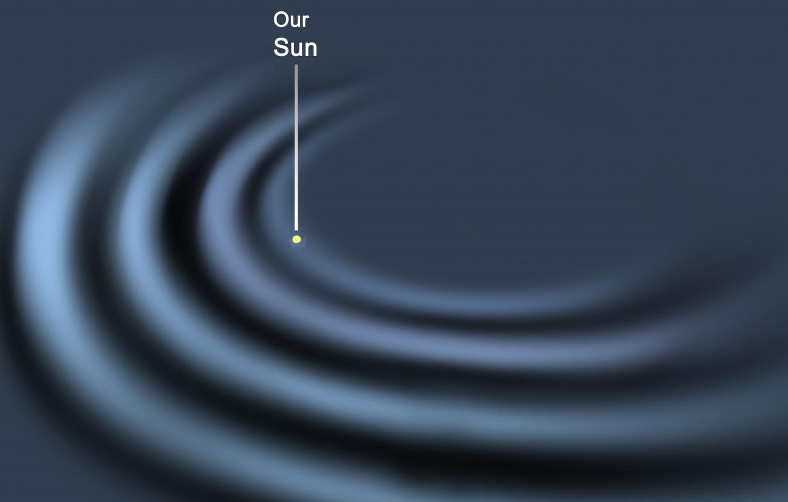Discovering that the Monoceros Ring (and, indeed, TriAndromeda Ring) are parts of the Milky Way means the galaxy is at least 50pc larger than previously thought. Via: Rensselaer Polytechnic Institute
Researchers have discovered that the Milky Way galaxy is around 50pc bigger than previously thought, with contouring ripples galore.
A team led by Professor Heidi Jo Newberg looked at 2002 astronomical data from the Sloan Digital Sky Survey, the same data that established the presence of a series of stars beyond what is known as our Milky Way.
“In essence, what we found is that the disk of the Milky Way isn’t just a disk of stars in a flat plane – it’s corrugated,” said Heidi Newberg, professor of physics, applied physics, and astronomy in the Rensselaer School of Science.
As the Milky Way stretches out from the sun the team noted at least four ripples, with the presumption that there are indeed further oscillations beyond what we can currently see.
Indeed the third ripple is actually the Monoceros Ring, a suite of stars previously thought to be 15,000 light years beyond our Milky Way. The discovery that this is, in fact, within our galaxy caused significant surprise amongst the team, especially for Newberg, who worked on the team that discovered Monoceros back in 2002.
“We thought it was a tidal debris stream,” she said in Discovery. “A dwarf galaxy that came in and spread itself out in this big ring. For 15 years, there’s been a controversy in the field where half the astronomers think it’s a tidal stream and half the astronomers think its something in the disk. I was in the stream camp.

Light measurements reveal our Milky Way has a series of contouring ripples. Via: Rensselaer Polytechnic Institute
“What I was trying to do was find more evidence that it was streams. It took a very long time to get this result, partly because I had to change my whole way of thinking. It now looks to me like it’s part of the disk,” she said.
This realisation also establishes that the size of our Milky Way is actually far bigger than we thought, now stretching 150,000 light years across, 50,000 light years more than previously thought.
“Going into the research, astronomers had observed that the number of Milky Way stars diminishes rapidly about 50,000 light-years from the centre of the Galaxy, and then a ring of stars appears at about 60,000 light-years from the centre,” said Yan Xu, lead author of the paper published in Astrophysics of Galaxies.
“What we see now is that this apparent ring is actually a ripple in the disc. And it may well be that there are more ripples further out which we have not yet seen.”
The ripples appear to line up with the galaxy’s spiral arms, with Newberg saying the team’s findings support other recent research.
This includes, according to Rensselaer, a theoretical finding that a dwarf galaxy or dark matter lump passing through the Milky Way would produce a ripple effect. The ripples may even lead to further knowledge on dark matter, that most elusive of subjects.
“It’s very similar to what would happen if you throw a pebble into still water – the waves will radiate out from the point of impact,” said Newberg. “If a dwarf galaxy goes through the disk, it would gravitationally pull the disk up as it comes in, and pull the disk down as it goes through, and this will set up a wave pattern that propagates outward. If you view this in the context of other research that’s emerged in the past two to three years, you start to see a picture is forming.”